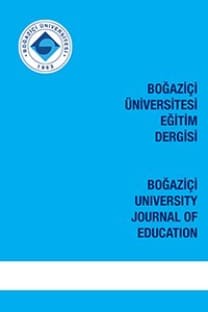Task Type in Reading Span Tests Matters: An Eye Movement Study
Working memory, Reading span tests, Secondary task, Eye movements, L2 sentence processing
Task Type in Reading Span Tests Matters: An Eye Movement Study
Working memory, Reading span tests, Secondary task, Eye movements, L2 sentence processing,
___
- Alptekin, C., & Erçetin, G. (2010). The role of L1 and L2 working memory in literal and inferential comprehension in L2 reading. Journal of Research in Reading, 33(2), 206–219.
- Braze, D., Shankweiler, D., Ni, W., & Palumbo, L. C. (2002). Readers’ eye movements distinguish anomalies of form and content. Journal of Psycholinguistic Research, 31, 25–44.
- Carpenter, P. A., & Just, M. A. (1989). The role of working memory in language comprehension. In D. K. Klahr and K. Kotovsky (Eds.), Complex information processing: The impact of Herbert A. Simon (pp. 31–68). Hillsdale, N.J.: Lawrence Erlbaum Associates.
- Clahsen, H., & Felser, C. (2006). Grammatical processing in language learners. Applied Psycholinguistics, 27, 3–42.
- Clifton, C., Jr., Staub, A., & Rayner, K. (2006) Eye movements in reading words and sentences. In R. P. G. van Gompel, M. H. Fischer, W. S.Murray, & R. L. Hill (Eds.), Eye movements: A window on mind and brain (pp. 341–371). Oxford: Elsevier.
- Daneman, M., & Carpenter, P. A. (1980). Individual differences in working memory and reading. Journal of Verbal Learning and Verbal Behavior, 19, 450–466.
- Frenck-Mestre, C. (2002). A on-line look at sentence processing in a second language. In R. Herrida & J. Altarriba (Eds.), Bilingual sentence processing (pp. 217–236). North Holland: Elsevier Science.
- Frenck-Mestre, C. & Pynte, J. (1997). Syntactic ambiguity resolution while reading in second and native languages. The Quarterly Journal of Experimental Psychology, 50A, 119–148.
- Friedman, N. P. & Miyake, A. (2004). The reading span test and its predictive power for reading comprehension ability. Journal of Memory and Language, 51, 136–158.
- Hannon, B., & Daneman, M. (2001). A new tool for measuring and understanding individual differences in the component processes of reading comprehension. Journal of Educational Psychology, 93(1), 103–128.
- Harrington, M., & Sawyer, M. (1992). L2 working memory capacity and L2 reading skill. Studies in Second Language Acquisition, 14, 25–38.
- van Hell, J. G., & Tokowicz, N. (2010). Event-related brain potentials and second language learning: Syntactic processing in late L2 learners at different L2 proficiency levels. Second Language Research, 26, 43–74.
- Just, M.A., & Carpenter, P.A. (1980). A theory of reading: From eye fixations to comprehension. Psychological Review, 87(4), 329-354.
- Kaakinen, J. K., & Hyönä, J. (2007). Strategy use in the reading span test: An analysis of eye movements and reported encoding strategies. Memory, 15(6), 634–646.
- Leeser, M.J., (2007). Learner-based factors in L2 reading comprehension and processing grammatical form: topic familiarity and working memory. Language Learning, 57, 229–270.
- Morgan-Short, K., & Ullman, M. T. (2012). The neurocognition of second language. In A. Mackey & S. Gass (Eds.), Handbook of second language acquisition (pp. 282–299). New York, NY: Routledge.
- Murray, W. S., & Rowan, M.(1998). Early, mandatory, pragmatic processing. Journal of Psycholinguistic Research, 27(1), 1-22.
- Ni,W., Fodor, J. D., Crain, S., & Shankweiler, D. (1998). Anomaly detection: eye movement patterns. Journal of Psycholinguistic Research, 27, 515–539.
- Rayner, K.,Warren, T., Juhasz, B. J., & Liversedge, S. P.(2004). The effect of plausibility on eye movements in reading. Journal of Experimental Psychology: Learning, Memory and Cognition, 30, 1290–1301.
- Roberts, L. (2010). Parsing the L2 input, an overview: Investigating L2 learners’ processing of syntactic ambiguities and dependencies in real-time comprehension. In G. D.Véronique (Ed.), Language, interaction and acquisition [Special issue], (pp. 189–205). Amsterdam: John Benjamins.
- Staub, A., Rayner, K., Pollatsek, A., Hyönä, J., & Majewski, H. (2007). The time course of plausibility effects on eye movements in reading: Evidence from noun–noun compounds. Journal of Experimental Psychology: Learning, Memory, and Cognition,33(6), 1162–1169.
- Tirre, W. C., & Pena, C. M. (1992). Investigation of functional working memory in the reading span test. Journal of Educational Psychology, 84(4), 462–472.
- Traxler, M.J., Pickering, M.J., & Clifton, C. (1998). Adjunct attachment is not a form of lexical ambiguity resolution. Journal of Memory and Language, 39, 558–592.
- Turner, M. L., & Engle, R. W. (1989). Is working memory capacity task dependent? Journal of Memory & Language, 28, 127–154.
- Ullman, M. T. (2001a). The declarative/procedural model of lexicon and grammar. Journal of Psycholinguistic Research, 30(1), 37–69.
- Ullman, M. T. (2001b). The neural basis of lexicon and grammar in first and second language: The declarative/procedural model. Bilingualism: Language and Cognition, 4(1), 105–122.
- Ullman, M. T. (2004). Contributions of memory circuits to language: The declarative/procedural model. Cognition, 92(1–2), 231–270.
- Ullman, M. T. (2005). A cognitive neuroscience perspective on second language acquisition: The declarative/procedural model. In C. Sanz (Ed.), Mind and context in adult second language acquisition: Methods, theory and practice (pp. 141–178). Washington, DC: Georgetown University Press.
- Walter, C. (2004). Transfer of reading comprehension skills to L2 is linked to mental representations of text and to L2 working memory. Applied Linguistics, 25(3), 315–339.
- Waters, G. S., & Caplan, D. (1996). The measurement of verbal working memory capacity and its relation to reading comprehension. The Quarterly Journal of Experimental Psychology, 49A(1), 51–79.
- ISSN: 1300-9567
- Yayın Aralığı: 3
- Başlangıç: 1976
- Yayıncı: Boğaziçi Üniversitesi
Problems Related to the Concept of Lingua Franca
The Development of Reading in Early Bilingualism: Evidence from Turkish-Child L2 Learners of English
Feride ÖZDEMİR, Belma HAZNEDAR, Nalan BABÜR
Who Should Be Teachers of English?
Task Type in Reading Span Tests Matters: An Eye Movement Study
